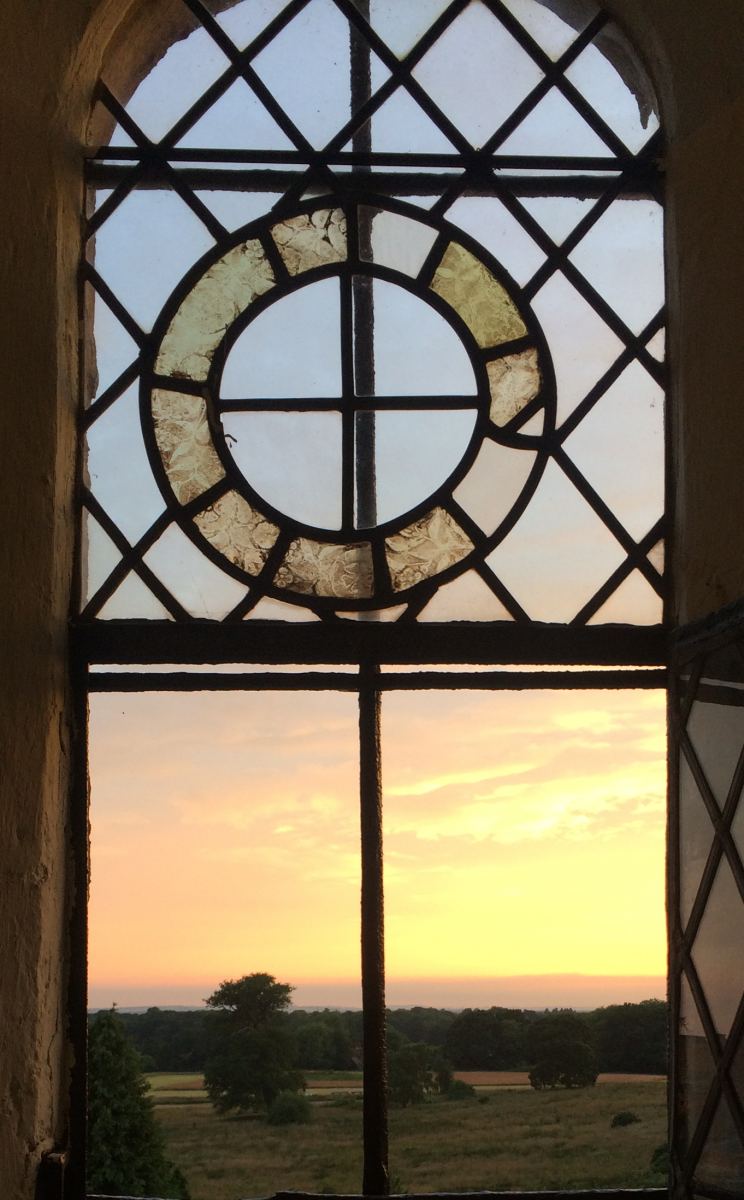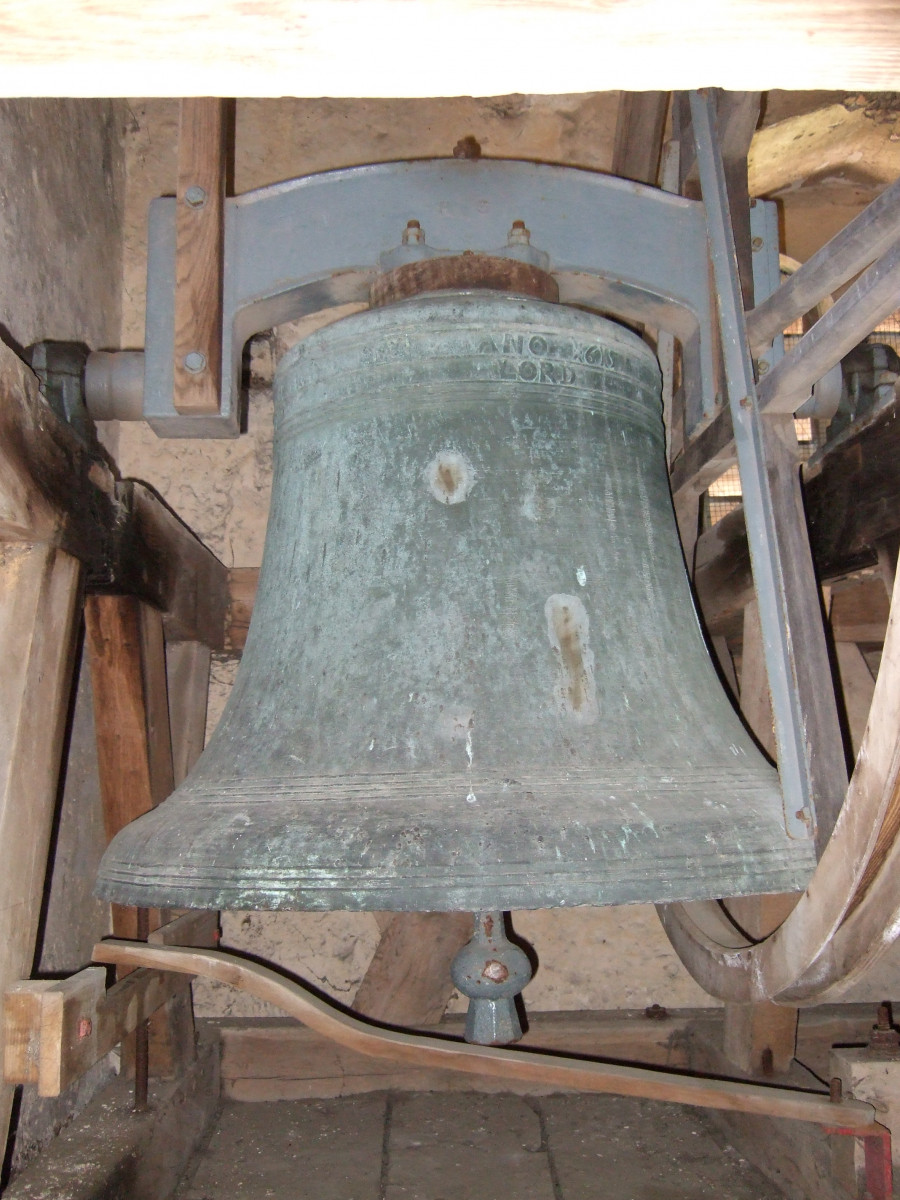 The sanctus bell is hung in a timber frame in an open turret on the roof of the tower. It weighs about a hundred weight and was cast in 1886 by John Warner and Sons of London
The sanctus bell is hung in a timber frame in an open turret on the roof of the tower. It weighs about a hundred weight and was cast in 1886 by John Warner and Sons of London
The other five bells are housed in the tower (behind the wooden louvers) and are rung from the chamber below that. They range from the lightest (the treble) with a diameter of 2’ 6” and weighing 5 cwt to the heaviest (the tenor) at 3’ 8” and 15 cwt (or ¾ ton).
The oldest bell is the third and was cast in Aldgate, London by Peter de Weston or his successor William Revell between 1328 and 1360. The bell founder has not left a name but it is known that both founders used this lettering. Other bells from these two founders are as far afield as Kent, East Anglia, Wiltshire and even Durham. There is a bell of Peter de Weston’s in the Museum of London. The inscription on the third reads “Now God help and have al”. It has been suggested by H B Walters that “have” should read ”save”. There could be several reasons for this and the spelling mistake, not least that most people were illiterate at the time. The letters would have been formed from wax castings.
The fourth is also old and interesting, being cast by the medieval Wokingham Foundry (located probably in Broad Street) between 1420 and 1448. It is inscribed “Sancta Margareta ora pro nobis” (Saint Margaret, pray for us) Saint Margaret of Antioch was a popular saint for bells and of course Latin was in common use in churches at this time. It also has three extra stamps: a grotesque lion’s head, a groat and a slanted crowned cross. The Wokingham Foundry was prolific and the fifth at Rotherwick is very similar to this bell, as is the tenor at Winchfield. The third at Rotherwick (late C14) and the treble at Mattingley (C13) are even earlier examples from the Wokingham Foundry although Mattingley, and Winchfield bells are not able to be rung “full circle”.
 The other three bells were cast in Reading, which was famous for bell founding. The tenor (heaviest) and treble (lightest) were both cast in 1615 by Henry Knight. Other local bells of his are at Odiham, Winchfield and Hartley Wintney. The second lightest bell (the Two) was cast by Ellis Knight in 1641. Other bells cast by him are at South Warnborough, Nately Scures and Greywell. Twelve members of the Knight family cast bells in Reading between 1518 and 1739 when the foundry moved to London. Henry and Ellis alone were founding for over 70 years (1587 – 1658) and an amazing 257 bells of theirs still exist. There was another separate foundry in Reading which is known to have cast bells from 1494 to 1616. It originated from the Wokingham foundry and also moved to London. Both foundries survived the very real difficulties of the Reformation when second hand bells flooded the market with the dissolution of the monastries and one of the Reading founders is known to have been tortured for his views as illustrated by the inscriptions on his bells.
The other three bells were cast in Reading, which was famous for bell founding. The tenor (heaviest) and treble (lightest) were both cast in 1615 by Henry Knight. Other local bells of his are at Odiham, Winchfield and Hartley Wintney. The second lightest bell (the Two) was cast by Ellis Knight in 1641. Other bells cast by him are at South Warnborough, Nately Scures and Greywell. Twelve members of the Knight family cast bells in Reading between 1518 and 1739 when the foundry moved to London. Henry and Ellis alone were founding for over 70 years (1587 – 1658) and an amazing 257 bells of theirs still exist. There was another separate foundry in Reading which is known to have cast bells from 1494 to 1616. It originated from the Wokingham foundry and also moved to London. Both foundries survived the very real difficulties of the Reformation when second hand bells flooded the market with the dissolution of the monastries and one of the Reading founders is known to have been tortured for his views as illustrated by the inscriptions on his bells.
The tenor has a vertical cross and the inscription “HENRI KNIGHT MADE THIS BELL ANO 1615” and “BLESED BE THE NAME OF THE LORD” The spelling is as shown. The language has reverted mainly to English, letters are all are upper case and the “I”s are unusual The letters would have been cut out of metal and are very different from the elaborate wax moulds used in earlier times.
The sanctus bell is hung in a timber frame in an open turret on the roof of the tower. It weighs about a hundred weight and was cast in 1886 by John Warner and Sons of London
